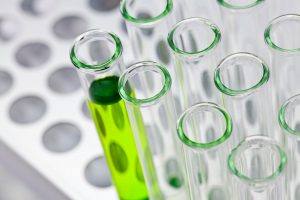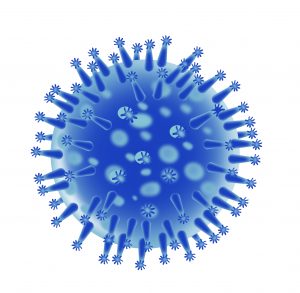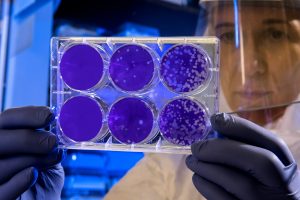The term true colloidal silver was coined by the Colloidal Science Laboratory (CSL) during the 1990s to describe a silver colloid whose silver content consisted mostly of silver nanoparticles vs. silver ions. To qualify as true colloidal silver the concentration of silver in the form of nanoparticles must be a majority of the total silver content (more than 50%). Total silver includes both ionic silver and silver in nanoparticle form. Silver concentration is determined using atomic absorption or atomic emission spectroscopy and is expressed in parts-per-million (PPM). PPM is a ratio of the mass of silver relative to the dispersant which is water. For example, 10 PPM means in one liter of water there are 10 milligrams of total silver content. True colloidal silver, therefore, refers to the percentage of silver in the form of nanoparticles being the majority of the total silver concentration. It does not mean that the product has any particular total silver concentration. A true silver colloid can technically exist at any silver concentration as long as the majority of the silver is in nanoparticles. By comparison, ionic silver products typically contain 1 to 10 percent nanoparticles, far less than true colloidal silver. Because these products are mostly ionic silver they are simply referred to as ionic silver.
How is True Colloidal Silver Determined
In order to determine if a silver product is true colloidal silver, the concentration of silver in nanoparticle form must be determined independently of the concentration of the silver ions present. Since most silver products contain both nanoparticles and ions a method of separating the ions from the nanoparticles was developed so that each component of the product could be determined. At the time this work was being conducted no definitive method had yet been established to separate silver ions from silver nanoparticles.
Figuring Out How to Separate Silver Ions from Silver Nanoparticles
Theory would dictate that centrifugal separation should do the trick but not even the scientists at companies that produced the Ultra Centrifuges of the day knew what forces would be required to cause the separation. Most laboratory centrifuges produce forces in the range of tens of thousands of G-forces. Ultra centrifuges produce forces of hundreds of thousands of G-forces ranging up to one million G-forces. After much trial and error, the scientists at CSL using an ultra-centrifuge capable of producing 650,000 G-forces determined the G-forces and time intervals required to separate silver ions from silver nanoparticles.

How Do We Know When the Nanoparticles Have Been Separated?
Part of this research involved determining when all the nanoparticles had been separated from the ions. This was accomplished using Dynamic Light Scattering (DLS) techniques that shine a powerful laser beam through the liquid and then count the individual photons that are reflected from the nanoparticles. The reflected laser energy is processed using digital signal processing algorithms to perform an auto correlation function and Fast Fourier Transform (FFT). When all the nanoparticles have been removed, the resulting output from the mathematical process will produce random noise. Should any nanoparticles be present, the mathematical process will produce a coherent output that is the result of the Brownian motion of the particles. This technique was of critical importance to knowing when all the nanoparticles had been removed by the ultra-centrifugation.
Determining the Ion vs. Nanoparticle Ratios
Once the nanoparticles were completely removed from the liquid, only the ions remained. The remaining ionic silver concentration (PPM) was measured using atomic absorption (AA) or atomic emission spectroscopy (AES).
A sample of the liquid containing both the ions and the particles is measured using an AA or AES to determine the total silver PPM. The particle concentration is calculated by subtracting the ionic PPM from the total PPM.
Nanoparticle PPM = Total PPM – Ionic PPM
From this we know the following:
- total silver concentration
- ionic silver concentration
- nanoparticle silver concentration
- Percent of nanoparticles = Nanoparticle PPM / Total PPM X 100
- Percent of ionic = Ionic PPM / Total PPM X 100
Is it Really True Colloidal Silver?

Once the items above have been determined it will be obvious if the liquid is really true colloidal silver. The true silver colloids will have a value of Percent of nanoparticles that exceeds 50 percent. Without the detailed laboratory analysis described above there is no way of knowing if a product is really true colloidal silver. Most companies advertising their product as true colloidal silver today don’t have a clue what the percent of nanoparticles is for the product they are selling. Try asking the manufacturer what the percentage of nanoparticles is and then ask for a copy of the lab analysis to prove their claim.
You can be sure a product is not true colloidal silver when:
- it is clear like water – it is ionic silver
- it is made by electrolysis which can be AC, DC or High Voltage AC (HVAC); they all make ionic silver
- electrolysis is sometimes described as an ‘electro-colloidal process’
- the manufacturer cannot produce a lab analysis page from an established laboratory detailing the values listed above.
- the product is described as mild silver protein or silver protein
- the silver concentration is very high (500 to 20000 PPM) – these are generally silver protein products
The Color of True Colloidal Silver
True colloidal silver is never clear like water because silver nanoparticles absorb light at a wavelength of 400 nm causing the liquid to have an amber color when observing a light source through the liquid. The darkness of the amber color is a general indication silver nanoparticle concentration. A five PPM product will appear light amber and a twenty PPM product will appear a much darker amber. A fifty PPM product will appear almost black. Just because a product is amber does not necessarily mean it is true colloidal silver. Ionic silver solutions made by electrolysis can appear amber or dark amber due to very large particles but without having particle concentrations above 50 percent.
Not All True Colloidal Silver Products are the Same
While there is a small handful of products that actually are true colloidal silver by the definition described on this page, there are vast differences between the various products. Particle concentration and particle size will determine the aggregate particle surface area per milliliter of the product. The higher the value of particle surface area the better because effectiveness is determined by particle surface area.

True Colloidal Silver Today
True silver colloids are not as prevalent as the ads for true colloidal silver would have you believe. By far the most prevalent form of product being sold today is ionic silver. However, many ionic silver products are now advertised as being true colloidal silver because this term has been hijacked and is being used to sell ionic silver product to the unsuspecting public. If it is advertised as being made by an ‘electro-colloidal process’ you can sure it is an ionic silver solution. Processes based on electrolysis all produce mostly ionic silver. So when you see a product being advertised as true colloidal silver that is made by electrolysis you can be sure it is really ionic silver, not a true silver colloid with a nanoparticle content more than 50% of the total silver.
Related Information
- Myth of Monatomic Colloidal Silver
- How to Compare Colloidal Silver Products
- Particle Surface Area and Effectiveness
- Ions, Atoms and Charged Particles
- Bioavailability of Colloidal Silver
- The Truth About TEM Images of Ionic Silver Solutions
- The Truth About Silver Protein Products
- Bogus Scientific Claims Made for Colloidal Silver Products
- The Truth About Colloid Particle Size
- Find colloidal silver products on the internet

